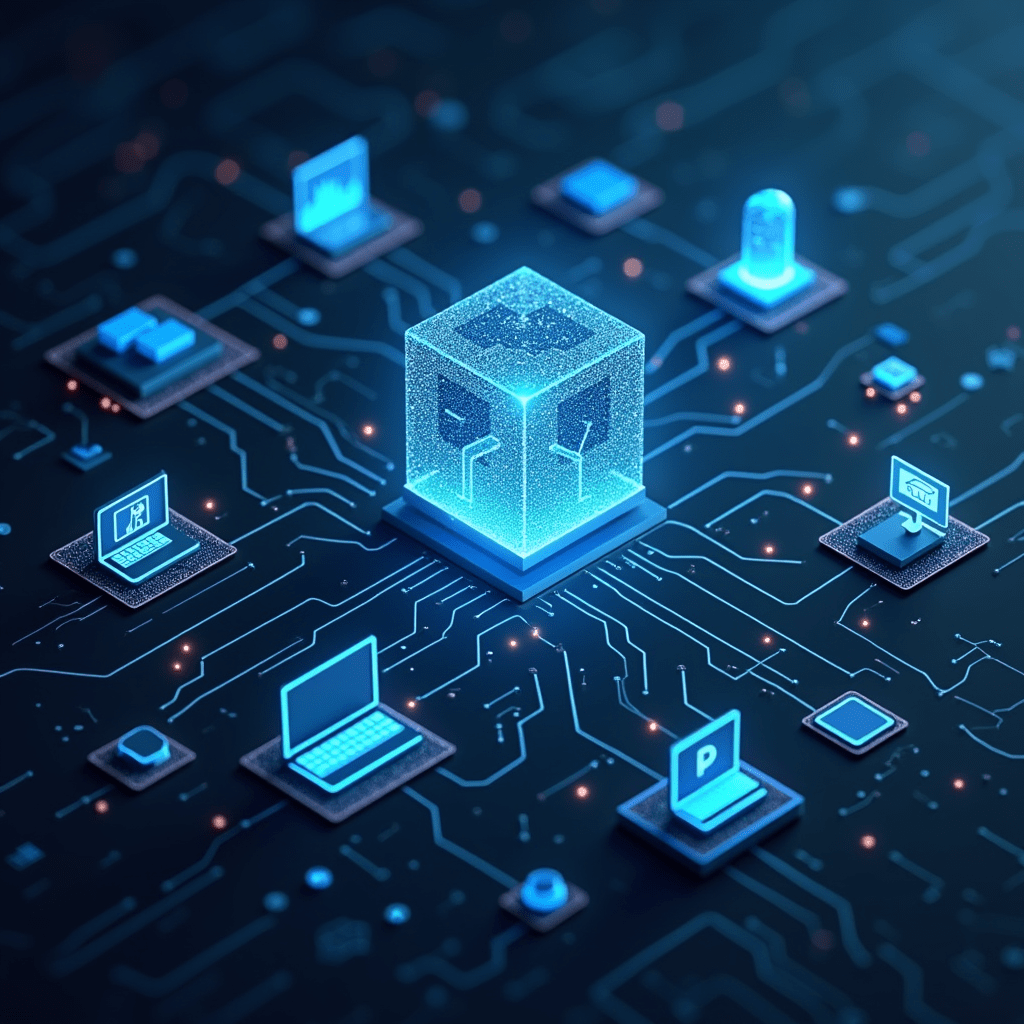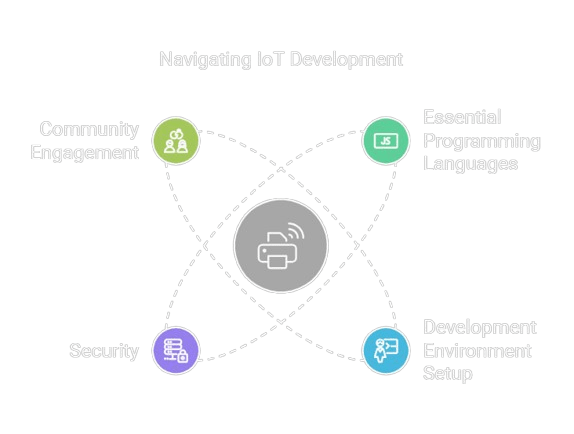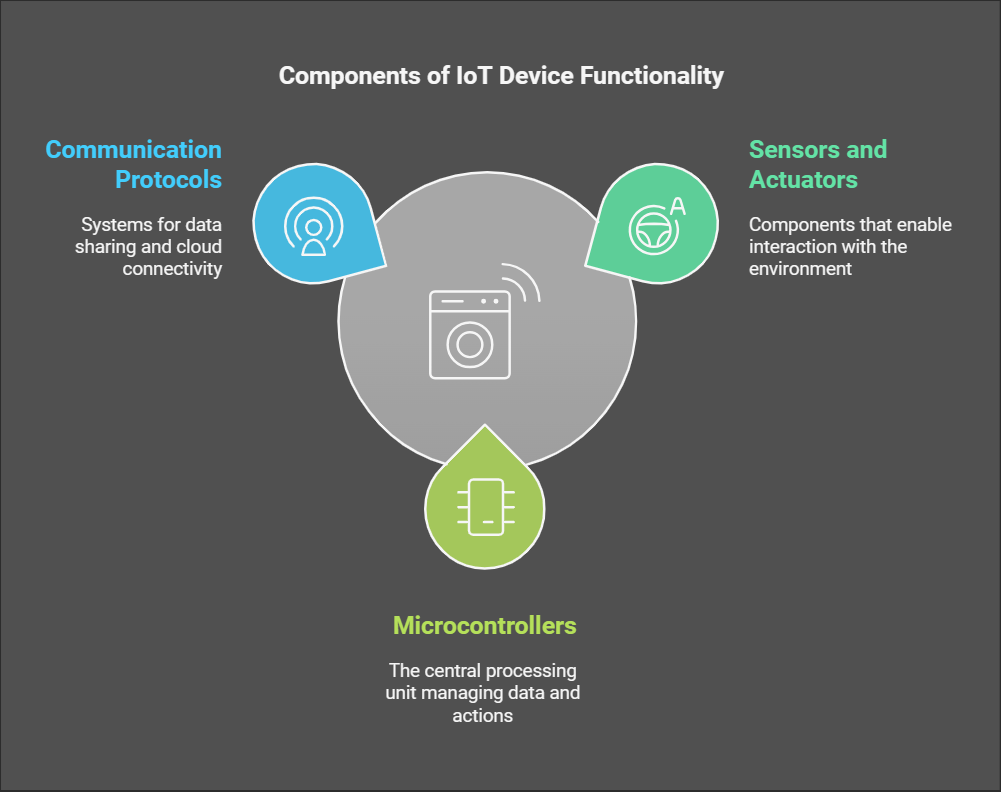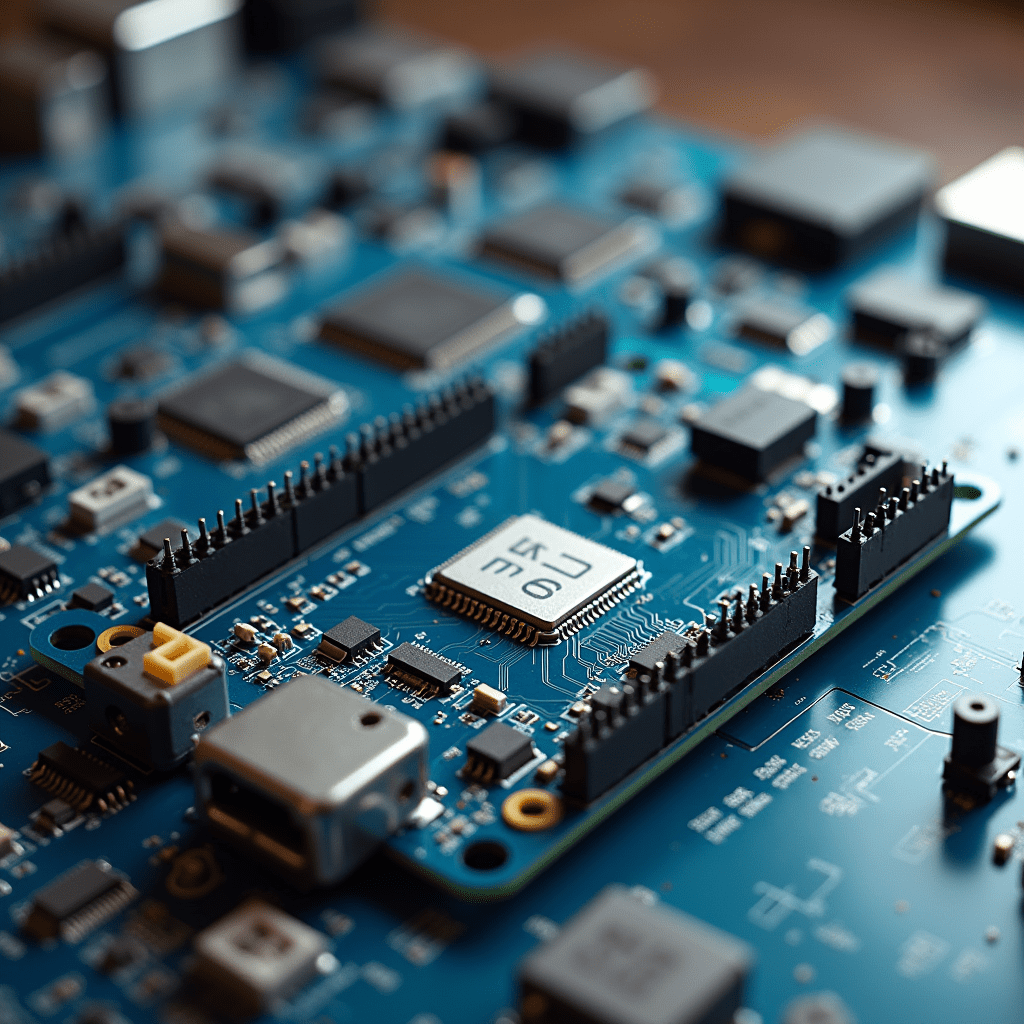Imagine controlling and connecting all devices in your life. This makes your world more convenient and efficient. Internet of Things programming is growing fast and changing how we live and work. As a beginner, learning this field might seem hard. But with the right guide, you can master the skills needed to succeed.

A futuristic workspace filled with various Internet of Things devices, such as smart home gadgets, wearables, and connected appliances, surrounded by a glowing circuit board pattern in the background, with digital screens displaying code and data streams, showcasing the integration of technology and programming in a sleek, modern environment.
Starting your journey in the Internet of Things programming, you’ll learn about iot development. You’ll discover the basics, essential programming languages, and tools. With this knowledge, you can create your own iot projects and join the growing iot developer community.
Key Takeaways
- Internet of Things programming is a rapidly growing field that is changing the way we live and work
- Learning iot development can seem daunting, but with the right guide, you can master the skills you need to succeed
- Understanding the basics of Internet of Things programming is essential for getting started in the field
- Essential programming languages for iot development include Python, C/C++, and JavaScript
- Setting up your iot development environment is critical for creating and testing your iot projects
- Security is a key part of iot development, and you’ll learn about secure communication and data encryption
- With the right skills and knowledge, you can create your own iot projects and connect with the growing iot developer community

Understanding the Fundamentals of Internet of Things Programming
To understand IoT programming, you need to know the basics of IoT. IoT is a network of devices, vehicles, and appliances with sensors and software. They collect and share data. This is key to iot coding and embedded systems programming.
Sensors, actuators, microcontrollers, and protocols are at the heart of IoT. They help devices sense their surroundings, process info, and talk to other devices. For example, a smart thermostat uses sensors to check the temperature. Then, it uses embedded systems programming to change the temperature.
Some important parts of IoT include:
- Sensors and actuators: These parts help devices interact with their surroundings.
- Microcontrollers: They are the brains of IoT devices, handling info and actions.
- Communication protocols: Protocols like Wi-Fi and MQTT let devices share data and connect to the cloud.

As we dive deeper into IoT, we’ll look at iot coding and embedded systems programming. We’ll cover programming languages, tools, and best practices. This will prepare you to start your own IoT projects and explore its many possibilities.
| Component | Description |
| Sensors | Detect environmental changes |
| Actuators | Perform actions based on sensor data |
| Microcontrollers | Process information and control actions |
Getting Started with IoT Development
To start with iot applications, knowing about iot devices is key. Picking the right devices and software is vital for success. Think about your project’s type, complexity, and your resources.
When picking iot devices, look at connectivity, sensor types, and power use. For wireless projects, choose devices with Wi-Fi, Bluetooth, or Zigbee. For precise projects, pick devices with advanced sensors.
Popular iot applications include smart homes, industrial automation, and wearables. Each needs specific iot devices and software. For example, smart homes need thermostats, lights, and cameras. Industrial projects need sensors, actuators, and control systems.
To start iot development, learn programming languages like Python, C++, or Java. Get to know development boards like Arduino or Raspberry Pi. Also, learn to work with sensors and actuators for interactive systems.
Here are steps to start with iot development:
- Choose a development board or platform that suits your needs
- Learn the basics of programming languages like Python or C++
- Familiarize yourself with iot devices and sensors
- Start with simple projects and gradually move on to more complex ones
Essential Programming Languages for IoT Devices
Choosing the right programming language for iot software development is key. The language impacts the device’s performance, security, and function. Many languages are popular in IoT for their ease of use and device compatibility.
Python is a top pick for IoT because it’s simple and has lots of libraries. It’s great for data analysis, machine learning, and automation. C/C++ is favored for embedded systems, where direct hardware control is needed. JavaScript and Node.js are also popular for web-based apps and handling real-time data.
- Device compatibility: The language must work with the device’s OS and hardware.
- Development ease: It should be easy to learn and have lots of resources.
- Security: It needs strong security features to protect against threats.
Knowing each language’s strengths and weaknesses helps developers make better choices. This leads to more efficient, secure, and reliable IoT devices.
| Language | Description | Use Cases |
| Python | High-level language with extensive libraries | Data analysis, machine learning, automation |
| C/C++ | Low-level language for direct hardware manipulation | Embedded systems, device drivers, firmware |
| JavaScript/Node.js | Web-based language for real-time data processing | Web applications, real-time data processing, IoT gateways |
Setting Up Your IoT Development Environment
To start working on IoT projects, you need the right setup. This means getting the right hardware and software. Iot programming tools are key for making, testing, and fixing your IoT apps.
Your IoT setup will have a microcontroller or single-board computer, sensors, and actuators. You’ll also need iot programming tools like IDEs, compilers, and debuggers. Some top IDEs for IoT work are Arduino IDE, Eclipse, and Visual Studio Code.

A lively workspace brimming with different IoT programming tools, featuring a stylish laptop displaying coding software, a microcontroller board with connected wires, sensors placed around, a digital multimeter, and a Raspberry Pi setup, all amidst circuit diagrams and vibrant sticky notes on a cheerful desk.
- Hardware components: microcontrollers, sensors, and actuators
- Software tools: IDEs, compilers, and debuggers
- Testing and debugging tools: serial monitors, logic analyzers, and debugging software
Choosing and setting up these elements well makes a great IoT development space. It supports your projects and helps you reach your goals with iot programming tools.
Building Your First IoT Project
Now that you know the basics of Internet of Things programming and iot development, it’s time to start your first project. This will help you get real-world experience. It will also boost your confidence in using IoT devices.
A good first project could be a smart lighting system or a weather station. These are easy because they need simple hardware and basic iot development skills.
Here’s how to start your first IoT project:
- Choose a project idea that interests you
- Gather the necessary hardware and software components
- Set up your development environment and start coding
- Test and debug your project to ensure it’s working as expected
Working on your project will enhance your knowledge of Internet of Things programming and IoT development. You’ll also gain skills in troubleshooting and resolving common issues.
Remember, start small and work your way up to bigger projects. With hard work and practice, you’ll get good at Internet of things programming. You’ll be able to make cool IoT solutions.
| Project Idea | Hardware Components | Software Components |
| Smart Lighting System | LED lights, microcontroller, sensors | Programming language, IoT framework |
| Weather Station | Temperature sensor, humidity sensor, microcontroller | Programming language, IoT framework, data analytics library |
IoT Connectivity and Communication Protocols
In iot coding, how devices talk to each other is key. Embedded systems programming uses MQTT, HTTP/REST APIs, and Wi-Fi, Bluetooth, and Zigbee. These help make IoT systems work well.
Some important protocols for IoT include:
- MQTT: A lightweight messaging protocol ideal for resource-constrained devices
- HTTP/REST APIs: Widely used for web-based applications and device management
- Wi-Fi, Bluetooth, and Zigbee: Popular wireless communication standards for device connectivity
Knowing these protocols is important for making IoT systems better. With iot coding and embedded systems programming skills, developers can make communication protocols that fit their IoT projects well.

A visual representation showcasing different IoT connectivity protocols, highlighting interconnected devices such as sensors, smartphones, and smart home appliances. Incorporate symbols for Wi-Fi, Bluetooth, Zigbee, and LoRaWAN, all illustrated in a vibrant, futuristic style. Use lines to depict data flow and communication among these devices, set against a tech-inspired background.
Choosing the right protocol for IoT depends on many things. These include what devices can do, the network, and what the project needs. By picking the best protocol, developers help devices talk smoothly. This makes IoT systems more efficient and effective.
| Protocol | Description | Application |
| MQTT | Lightweight messaging protocol | Resource-constrained devices |
| HTTP/REST APIs | Web-based application protocol | Device management and web-based applications |
| Wi-Fi, Bluetooth, Zigbee | Wireless communication standards | Device connectivity and communication |
Data Management and Processing in IoT Systems
Data management and processing are key in IoT systems. They help handle lots of data from IoT devices. Cloud computing is important here, as it offers a safe and big space for data.
Data analytics are vital in IoT systems. They help find important information in the data from IoT devices. This is done using machine learning and data mining. The insights help make IoT apps better and more efficient.
Here are some important points for data management and processing in IoT systems:
- Scalability: The ability to handle large amounts of data from IoT devices
- Security: Ensuring the secure transmission and storage of data
- Real-time processing: The ability to process data in real-time to support applications such as smart home automation
By using cloud computing and data analytics, IoT apps can reach their full power. This drives new ideas in many fields.
| IoT Application | Data Management Requirement |
| Smart Home Automation | Real-time data processing and secure data transmission |
| Industrial IoT | Scalable data storage and advanced data analytics |
Security Best Practices for IoT Programming
IoT devices are everywhere now, and keeping them safe is key. In iot software development, security is a big deal. Developers must think about the risks each iot coding language brings.
To keep IoT systems safe, follow these steps:
- Use strong ways to check who can access the system
- Encrypt data to keep it safe from prying eyes
- Choose secure ways to talk to the system to stop hacking
By doing these things, developers can lower the chance of security problems. This is very important in iot software development. Knowing how different iot coding languages work helps make things safer.
Remember, security never stops. Always learn about new ways to keep things safe. By focusing on security in iot software development, developers can make IoT systems safer and more reliable.

A futuristic digital landscape featuring interconnected smart devices adorned with glowing locks and shields, representing strong security. Incorporate elements such as data streams and circuit patterns flowing between the devices, all set against a dark backdrop illuminated by vibrant neon lights.
| Security Measure | Description |
| Authentication | Verifying the identity of devices and users |
| Authorization | Controlling access to resources and data |
| Data Encryption | Protecting sensitive information from unauthorized access |
Advanced IoT Applications and Use Cases
Exploring the Internet of Things programming shows us how it’s changing industries. iot programming tools help developers make new solutions. It’s exciting to see how the Internet of Things programming is changing our lives and work.
Some key areas where iot programming tools are making a big difference include:
- Smart Home Automation: making homes more convenient and seamless
- Industrial IoT Solutions: making factories more efficient and safe
- Healthcare IoT Applications: improving patient care and monitoring
These examples show the power of iot programming tools and Internet of Things programming. As tech gets better, we’ll see even more new ideas. These ideas will change how we live, work, and interact with the world.
Using internet of Things programming and iot programming tools, developers can make amazing solutions. These solutions can help grow and improve many areas. The future looks very promising, with endless possibilities in smart homes, factories, and healthcare.
| Application | Description |
| Smart Home Automation | Integrating devices and systems for a seamless living experience |
| Industrial IoT Solutions | Improving efficiency, productivity, and safety in manufacturing and production environments |
| Healthcare IoT Applications | Enhancing patient care, monitoring, and treatment through connected devices and systems |
Conclusion: Launching Your IoT Programming Journey
The world of Internet of Things (IoT) programming is exciting and always changing. You’ve learned the basics and how to start your first project. This guide has given you the tools to begin your IoT journey.
You now know about IoT technology, programming languages, and how to do it well. It’s time to use what you’ve learned. Look for online IoT groups, go to local meetups, or help with open-source projects. This will help you keep learning and growing.
The IoT offers endless chances to make a difference. You could change smart homes or industrial processes. With your hard work and love for IoT, you can be part of this big change. Be brave, stay curious, and let your creativity shine as you start your IoT adventure.
FAQ
What is IoT programming and why is it important?
IoT programming means making software for devices connected to the internet. It’s key because it changes many fields. It brings new chances, better work, and smart choices based on data.
What are the core components of an IoT system?
An IoT system has sensors, actuators, and microcontrollers. It also has communication protocols and cloud or edge computing. These parts help gather data and control devices from afar.
What are the popular programming languages used for IoT development?
Python, C/C++, and JavaScript/Node.js are top choices for IoT. Each is good for different tasks, making IoT work well in many areas.
How do I set up my IoT development environment?
First, get the right hardware like microcontrollers and sensors. Then, install software tools and IDEs. Make sure they match your programming language and IoT platform.
What are the key security considerations for IoT programming?
For IoT security, use strong passwords and encryption. Choose secure communication methods. Keeping systems safe from threats is vital to avoid data loss.
What are some popular IoT applications and use cases?
IoT is used in smart homes, industrial settings, and healthcare. It makes things work better and opens up new possibilities.
read more article: click hare
